Representation Model of Requests to Web Resources, Based on a Vector Space Model and Attributes of Requests for HTTP Protocol
Trong những năm gần đây, số
lượng sự cố liên quan đến các ứng dụng Web có
xu hướng tăng lên do sự gia tăng số lượng người
dùng thiết bị di động, sự phát triển của Internet
cũng như sự mở rộng của nhiều dịch vụ của nó.
Do đó càng làm tăng khả năng bị tấn công vào
thiết bị di động của người dùng cũng như hệ
thống máy tính. Mã độc thường được sử dụng để
thu thập thông tin về người dùng, dữ liệu cá
nhân nhạy cảm, truy cập vào tài nguyên Web
hoặc phá hoại các tài nguyên này. Mục đích của
nghiên cứu nhằm tăng cường độ chính xác phát
hiện các cuộc tấn công máy tính vào các ứng
dụng Web. Bài báo trình bày một mô hình biểu
diễn các yêu cầu Web, dựa trên mô hình không
gian vectơ và các thuộc tính của các yêu cầu đó
sử dụng giao thức HTTP. So sánh với các nghiên
cứu được thực hiện trước đây cho phép chúng
tôi ước tính độ chính xác phát hiện xấp xỉ 96%
cho các ứng dụng Web khi sử dụng bộ dữ liệu
KDD 99 trong đào tạo cũng như phát hiện tấn
công đi kèm với việc biểu diễn truy vấn dựa trên
không gian vectơ và phân loại dựa trên mô hình
cây quyết định.
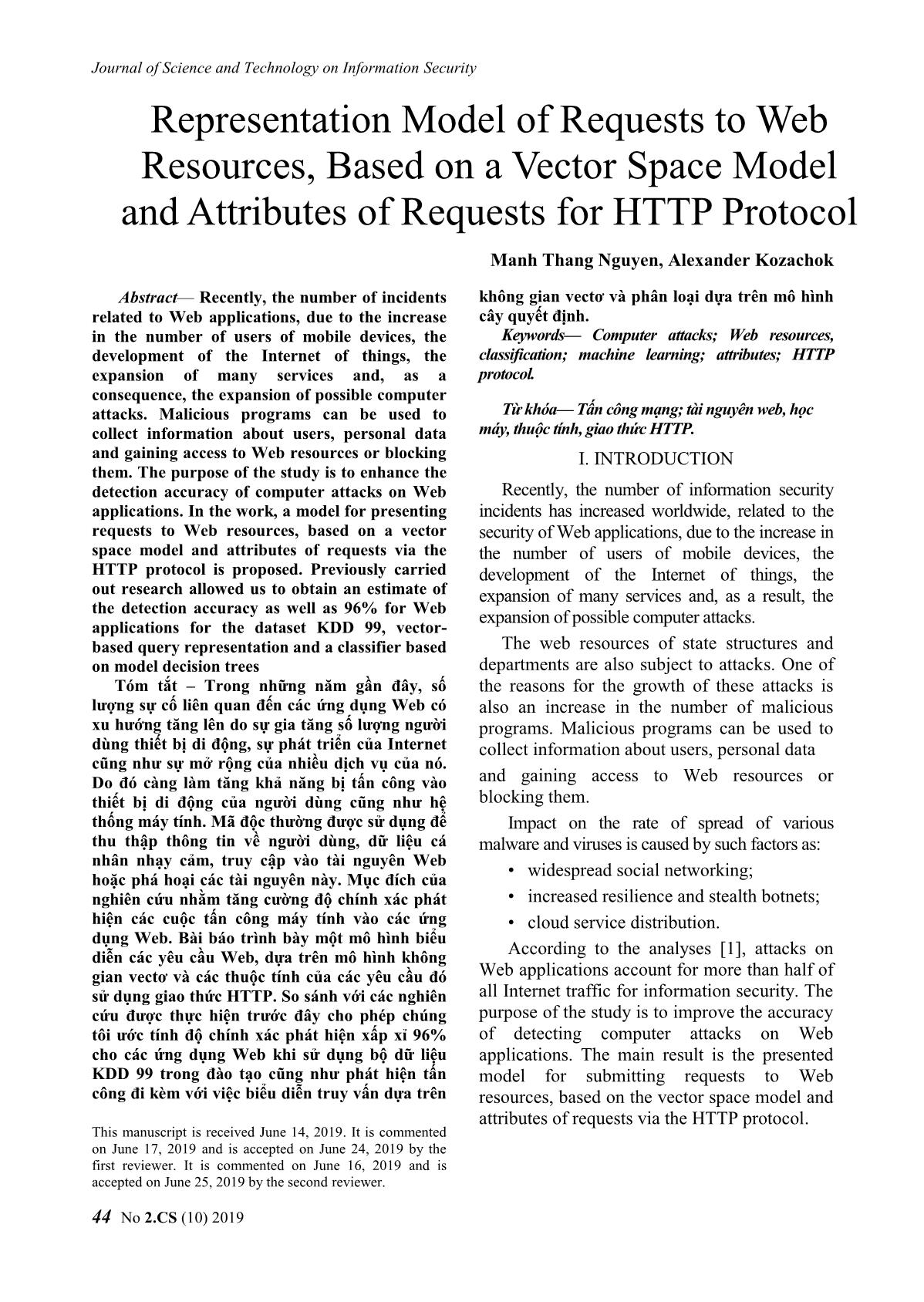
Trang 1
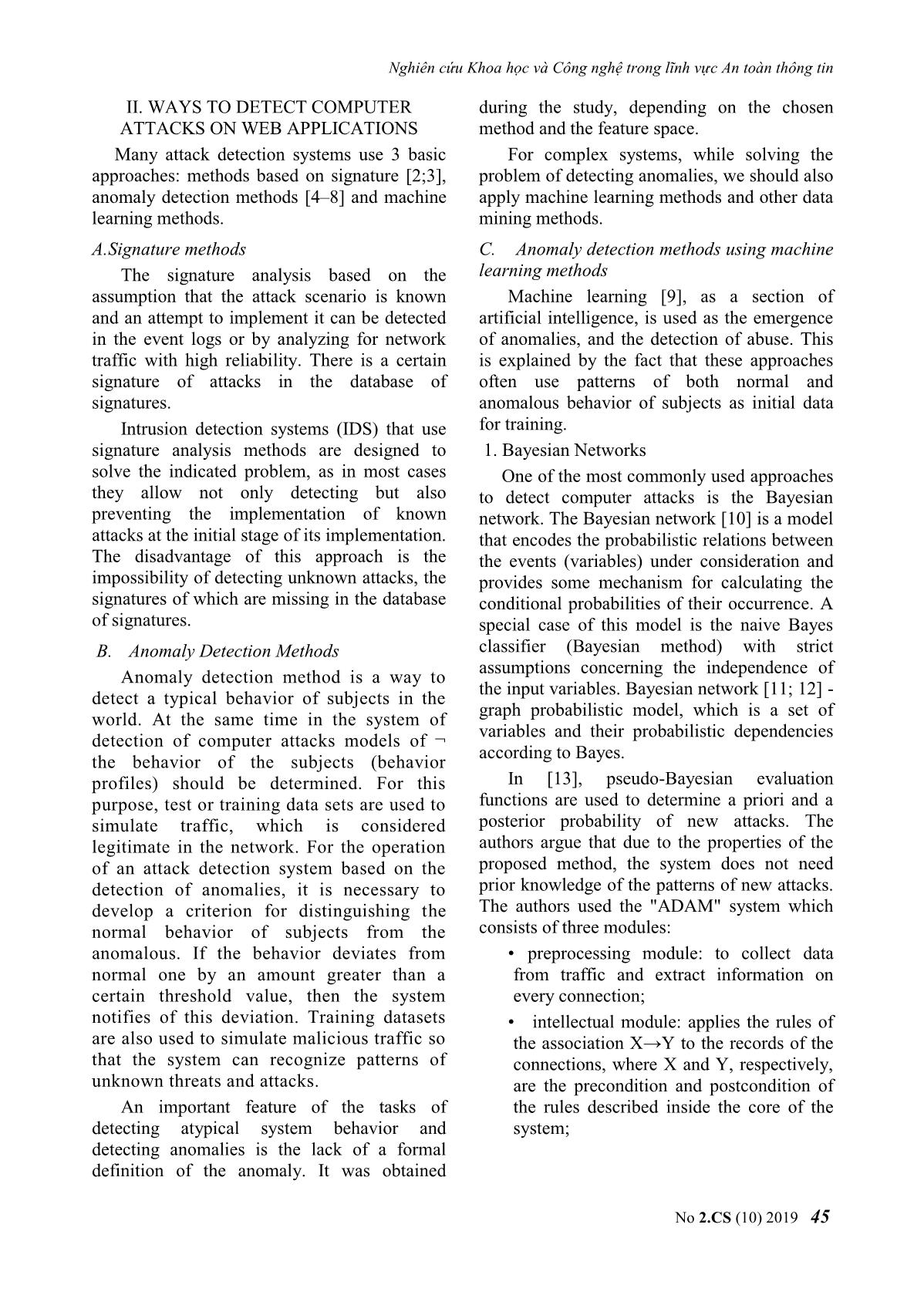
Trang 2
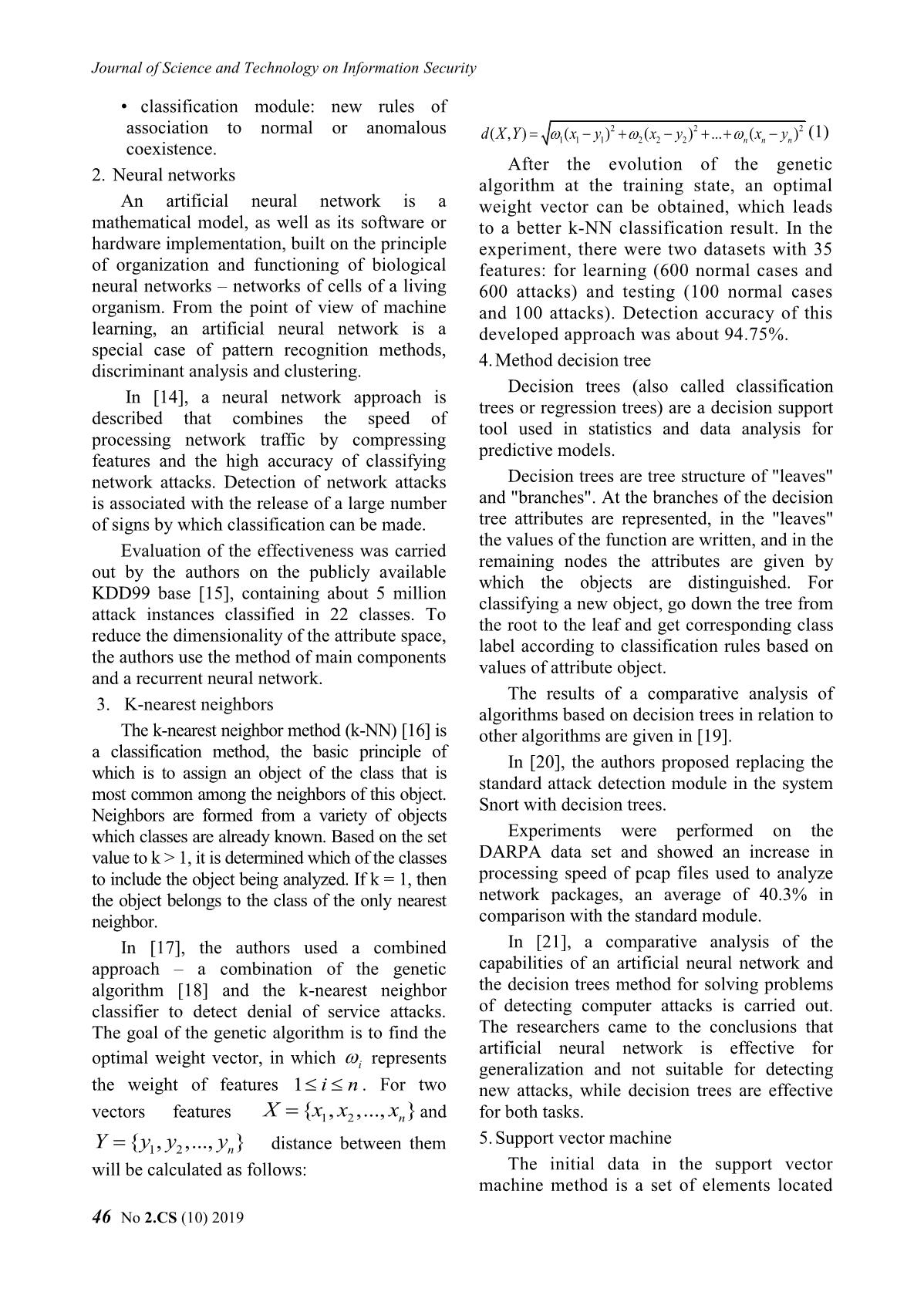
Trang 3
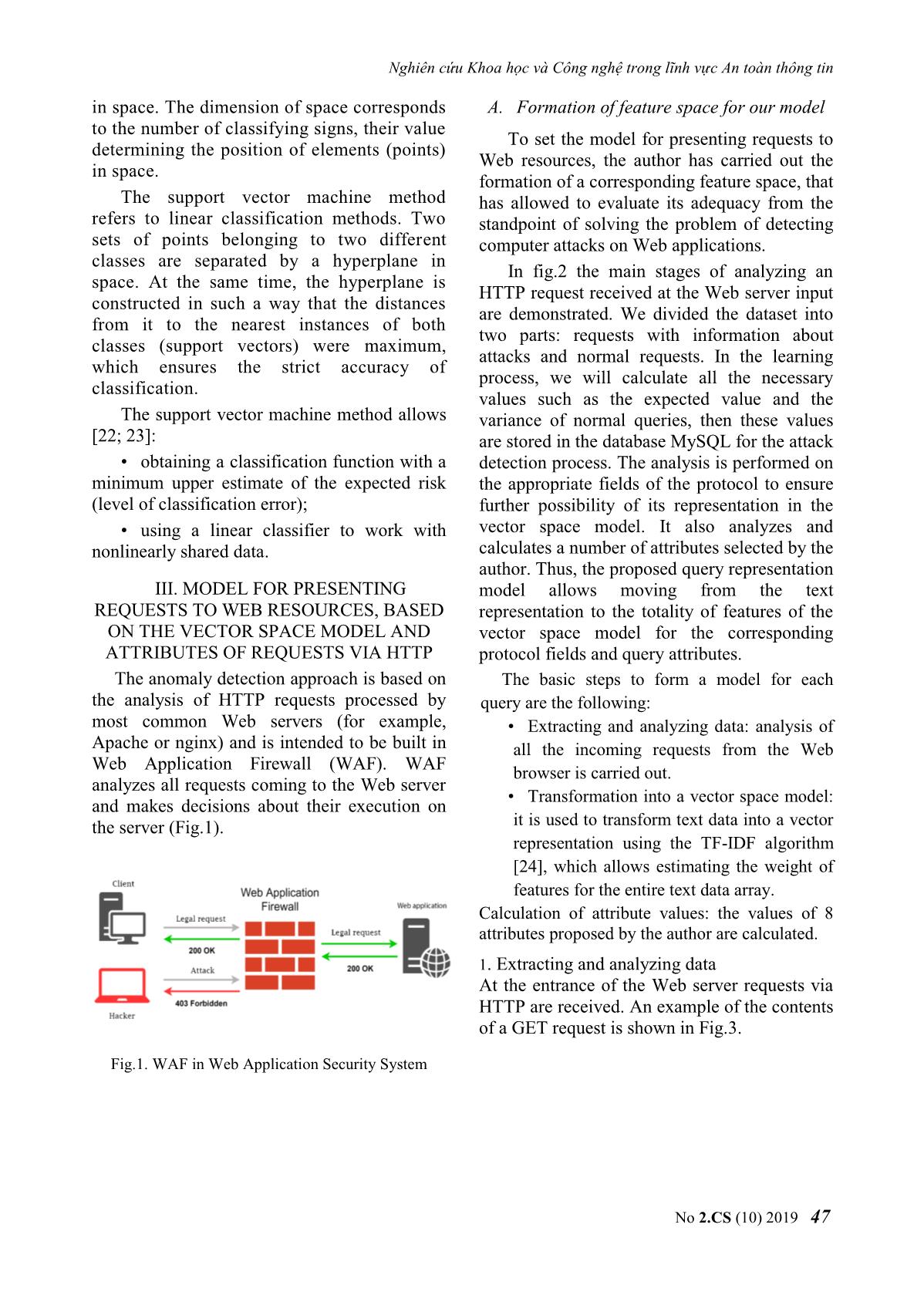
Trang 4
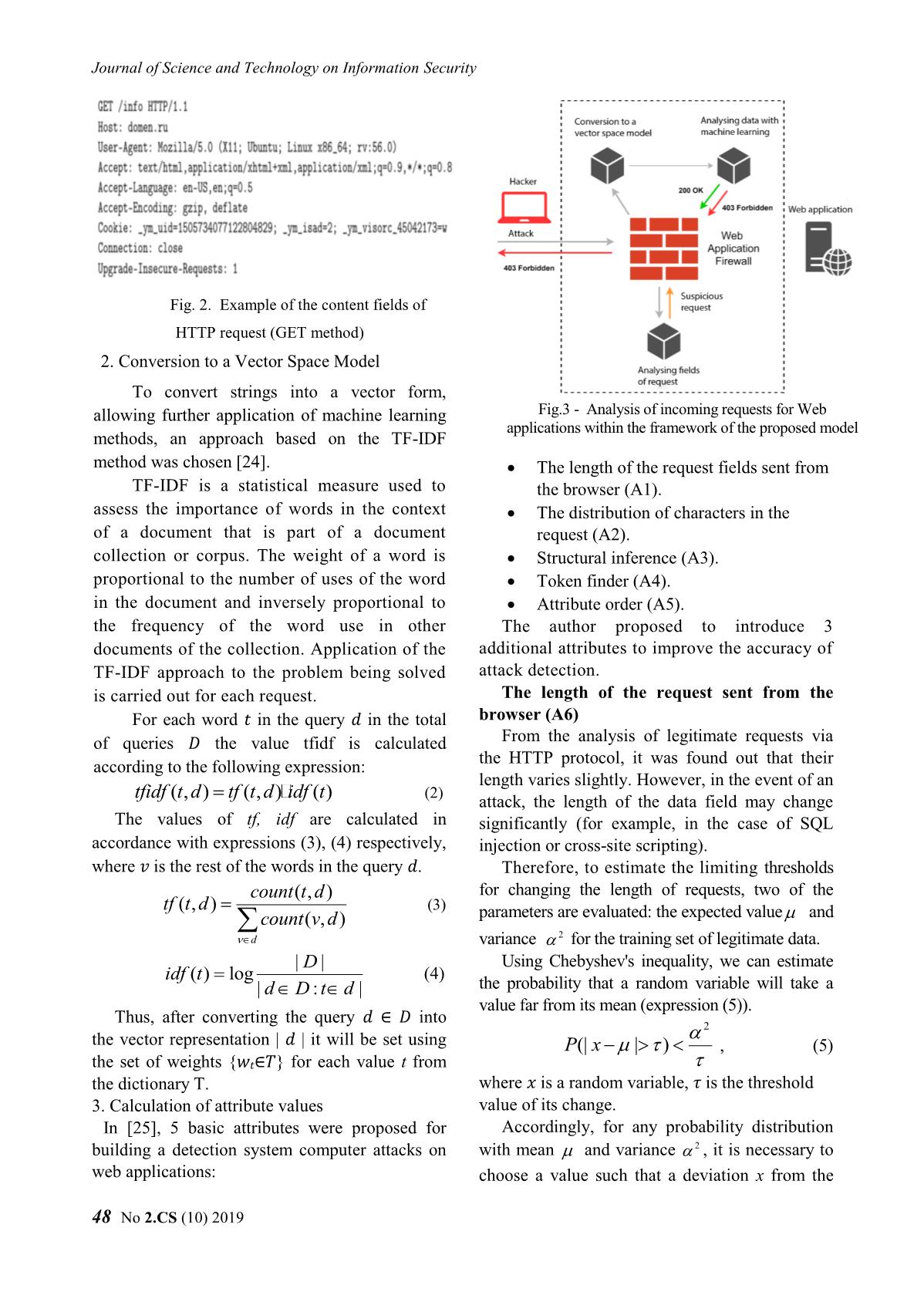
Trang 5
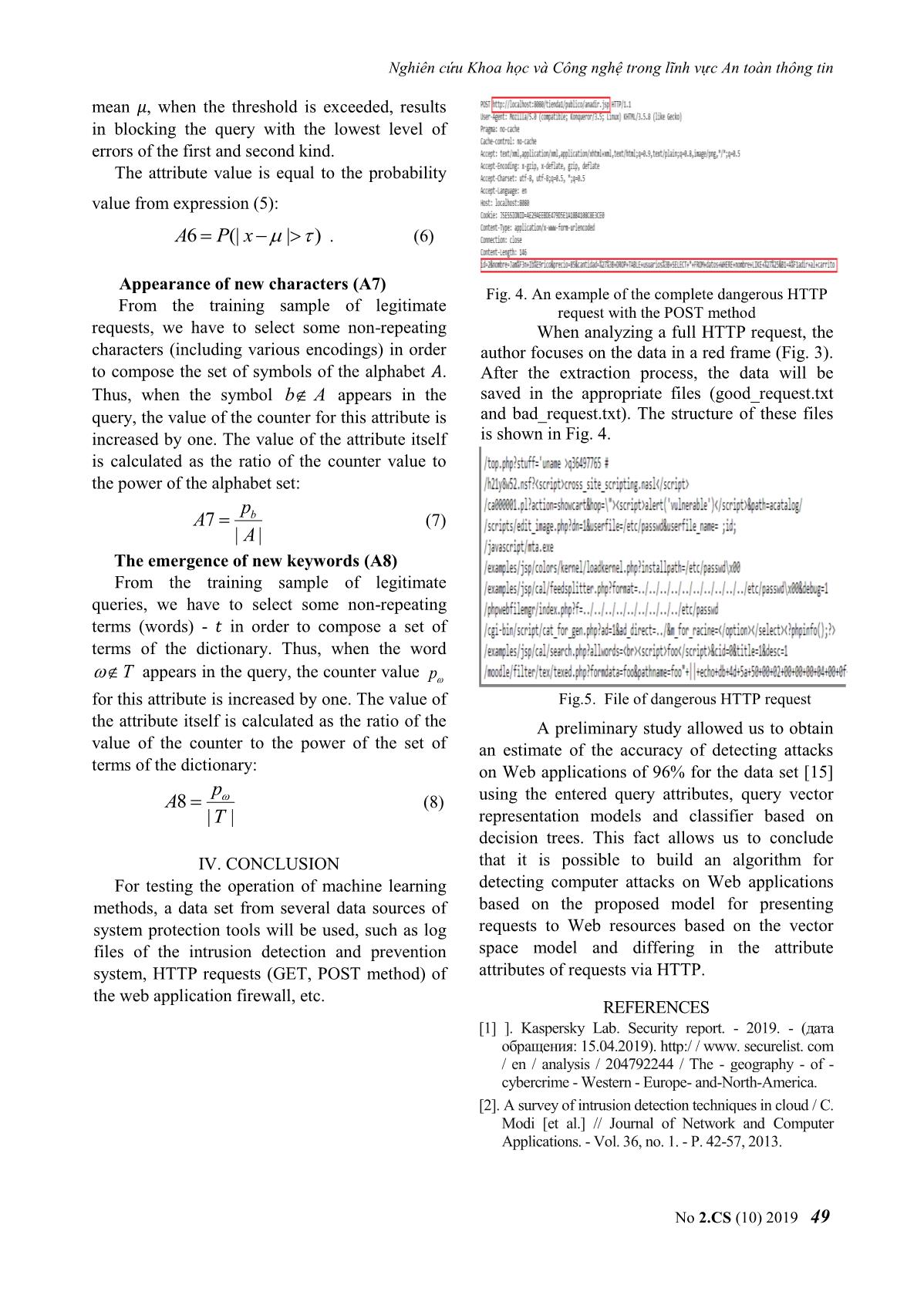
Trang 6
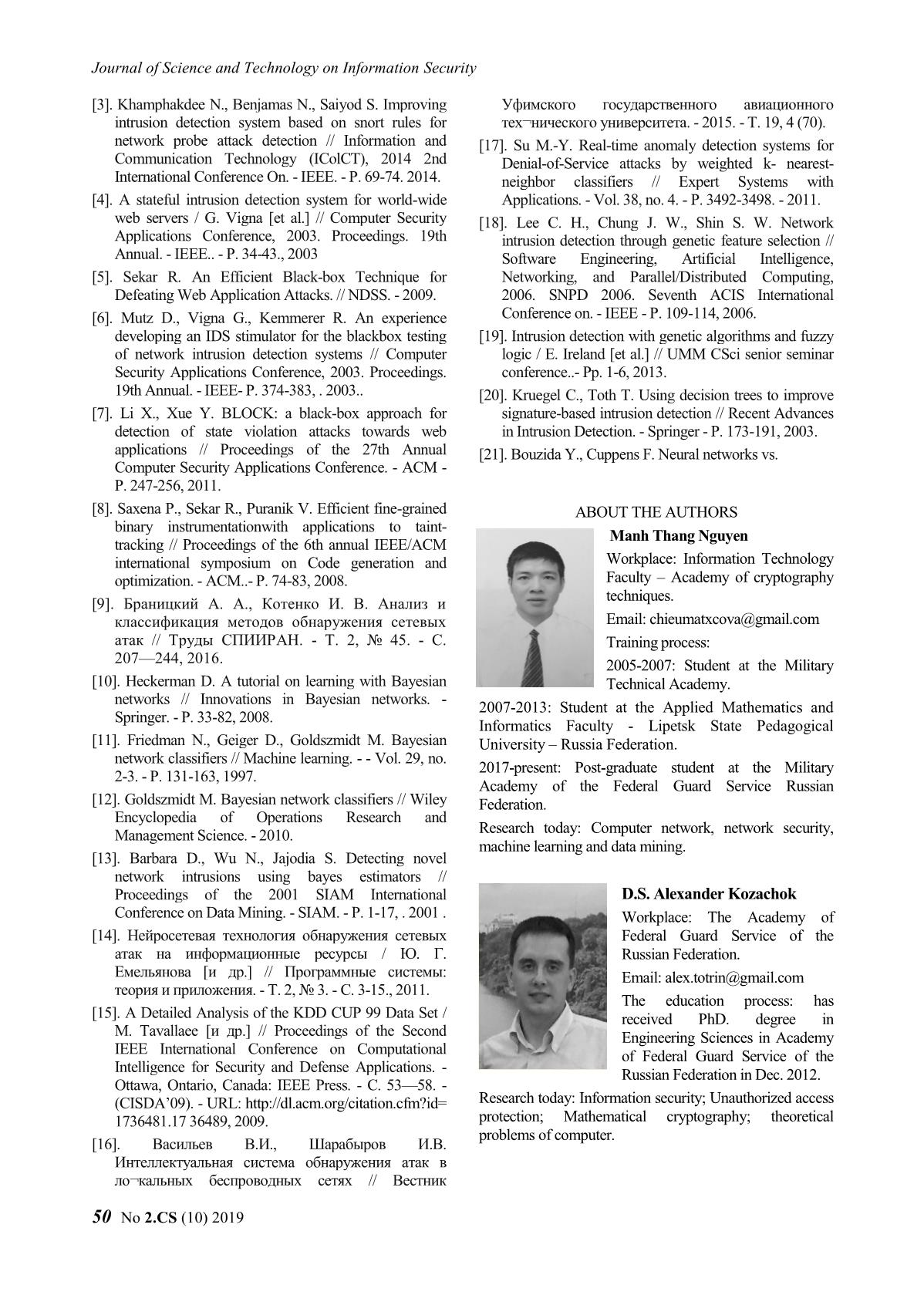
Trang 7
Tóm tắt nội dung tài liệu: Representation Model of Requests to Web Resources, Based on a Vector Space Model and Attributes of Requests for HTTP Protocol
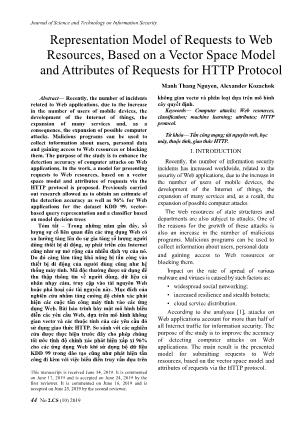
Journal of Science and Technology on Information Security
44 No 2.CS (10) 2019
Manh Thang Nguyen, Alexander Kozachok
Abstract— Recently, the number of incidents
related to Web applications, due to the increase
in the number of users of mobile devices, the
development of the Internet of things, the
expansion of many services and, as a
consequence, the expansion of possible computer
attacks. Malicious programs can be used to
collect information about users, personal data
and gaining access to Web resources or blocking
them. The purpose of the study is to enhance the
detection accuracy of computer attacks on Web
applications. In the work, a model for presenting
requests to Web resources, based on a vector
space model and attributes of requests via the
HTTP protocol is proposed. Previously carried
out research allowed us to obtain an estimate of
the detection accuracy as well as 96% for Web
applications for the dataset KDD 99, vector-
based query representation and a classifier based
on model decision trees
Tóm tắt – Trong những năm gần đây, số
lượng sự cố liên quan đến các ứng dụng Web có
xu hướng tăng lên do sự gia tăng số lượng người
dùng thiết bị di động, sự phát triển của Internet
cũng như sự mở rộng của nhiều dịch vụ của nó.
Do đó càng làm tăng khả năng bị tấn công vào
thiết bị di động của người dùng cũng như hệ
thống máy tính. Mã độc thường được sử dụng để
thu thập thông tin về người dùng, dữ liệu cá
nhân nhạy cảm, truy cập vào tài nguyên Web
hoặc phá hoại các tài nguyên này. Mục đích của
nghiên cứu nhằm tăng cường độ chính xác phát
hiện các cuộc tấn công máy tính vào các ứng
dụng Web. Bài báo trình bày một mô hình biểu
diễn các yêu cầu Web, dựa trên mô hình không
gian vectơ và các thuộc tính của các yêu cầu đó
sử dụng giao thức HTTP. So sánh với các nghiên
cứu được thực hiện trước đây cho phép chúng
tôi ước tính độ chính xác phát hiện xấp xỉ 96%
cho các ứng dụng Web khi sử dụng bộ dữ liệu
KDD 99 trong đào tạo cũng như phát hiện tấn
công đi kèm với việc biểu diễn truy vấn dựa trên
This manuscript is received June 14, 2019. It is commented
on June 17, 2019 and is accepted on June 24, 2019 by the
first reviewer. It is commented on June 16, 2019 and is
accepted on June 25, 2019 by the second reviewer.
không gian vectơ và phân loại dựa trên mô hình
cây quyết định.
Keywords— Computer attacks; Web resources,
classification; machine learning; attributes; HTTP
protocol.
Từ khóa— Tấn công mạng; tài nguyên web, học
máy, thuộc tính, giao thức HTTP.
I. INTRODUCTION
Recently, the number of information security
incidents has increased worldwide, related to the
security of Web applications, due to the increase in
the number of users of mobile devices, the
development of the Internet of things, the
expansion of many services and, as a result, the
expansion of possible computer attacks.
The web resources of state structures and
departments are also subject to attacks. One of
the reasons for the growth of these attacks is
also an increase in the number of malicious
programs. Malicious programs can be used to
collect information about users, personal data
and gaining access to Web resources or
blocking them.
Impact on the rate of spread of various
malware and viruses is caused by such factors as:
• widespread social networking;
• increased resilience and stealth botnets;
• cloud service distribution.
According to the analyses [1], attacks on
Web applications account for more than half of
all Internet traffic for information security. The
purpose of the study is to improve the accuracy
of detecting computer attacks on Web
applications. The main result is the presented
model for submitting requests to Web
resources, based on the vector space model and
attributes of requests via the HTTP protocol.
Representation Model of Requests to Web
Resources, Based on a Vector Space Model
and Attributes of Requests for HTTP Protocol
Nghiên cứu Khoa học và Công nghệ trong lĩnh vực An toàn thông tin
No 2.CS (10) 2019 45
II. WAYS TO DETECT COMPUTER
ATTACKS ON WEB APPLICATIONS
Many attack detection systems use 3 basic
approaches: methods based on signature [2;3],
anomaly detection methods [4–8] and machine
learning methods.
A. Signature methods
The signature analysis based on the
assumption that the attack scenario is known
and an attempt to implement it can be detected
in the event logs or by analyzing for network
traffic with high reliability. There is a certain
signature of attacks in the database of
signatures.
Intrusion detection systems (IDS) that use
signature analysis methods are designed to
solve the indicated problem, as in most cases
they allow not only detecting but also
preventing the implementation of known
attacks at the initial stage of its implementation.
The disadvantage of this approach is the
impossibility of detecting unknown attacks, the
signatures of which are missing in the database
of signatures.
B. Anomaly Detection Methods
Anomaly detection method is a way to
detect a typical behavior of subjects in the
world. At the same time in the system of
detection of computer attacks models of ¬
the behavior of the subjects (behavior
profiles) should be determined. For this
purpose, test or training data sets are used to
simulate traffic, which is considered
legitimate in the network. For the operation
of an attack detection system based on the
detection of anomalies, it is necessary to
develop a criterion for distinguishing the
normal behavior of subjects from the
anomalous. If the behavior deviates from
normal one by an amount greater than a
certain threshold value, then the system
notifies of this deviation. Training datasets
are also used to simulate malicious traffic so
that the system can recognize patterns of
unknown threats and att ... ng lĩnh vực An toàn thông tin
No 2.CS (10) 2019 47
in space. The dimension of space corresponds
to the number of classifying signs, their value
determining the position of elements (points)
in space.
The support vector machine method
refers to linear classification methods. Two
sets of points belonging to two different
classes are separated by a hyperplane in
space. At the same time, the hyperplane is
constructed in such a way that the distances
from it to the nearest instances of both
classes (support vectors) were maximum,
which ensures the strict accuracy of
classification.
The support vector machine method allows
[22; 23]:
• obtaining a classification function with a
minimum upper estimate of the expected risk
(level of classification error);
• using a linear classifier to work with
nonlinearly shared data.
III. MODEL FOR PRESENTING
REQUESTS TO WEB RESOURCES, BASED
ON THE VECTOR SPACE MODEL AND
ATTRIBUTES OF REQUESTS VIA HTTP
The anomaly detection approach is based on
the analysis of HTTP requests processed by
most common Web servers (for example,
Apache or nginx) and is intended to be built in
Web Application Firewall (WAF). WAF
analyzes all requests coming to the Web server
and makes decisions about their execution on
the server (Fig.1).
Fig.1. WAF in Web Application Security System
A. Formation of feature space for our model
To set the model for presenting requests to
Web resources, the author has carried out the
formation of a corresponding feature space, that
has allowed to evaluate its adequacy from the
standpoint of solving the problem of detecting
computer attacks on Web applications.
In fig.2 the main stages of analyzing an
HTTP request received at the Web server input
are demonstrated. We divided the dataset into
two parts: requests with information about
attacks and normal requests. In the learning
process, we will calculate all the necessary
values such as the expected value and the
variance of normal queries, then these values
are stored in the database MySQL for the attack
detection process. The analysis is performed on
the appropriate fields of the protocol to ensure
further possibility of its representation in the
vector space model. It also analyzes and
calculates a number of attributes selected by the
author. Thus, the proposed query representation
model allows moving from the text
representation to the totality of features of the
vector space model for the corresponding
protocol fields and query attributes.
The basic steps to form a model for each
query are the following:
• Extracting and analyzing data: analysis of
all the incoming requests from the Web
browser is carried out.
• Transformation into a vector space model:
it is used to transform text data into a vector
representation using the TF-IDF algorithm
[24], which allows estimating the weight of
features for the entire text data array.
Calculation of attribute values: the values of 8
attributes proposed by the author are calculated.
1. Extracting and analyzing data
At the entrance of the Web server requests via
HTTP are received. An example of the contents
of a GET request is shown in Fig.3.
Journal of Science and Technology on Information Security
48 No 2.CS (10) 2019
Fig. 2. Example of the content fields of
HTTP request (GET method)
2. Conversion to a Vector Space Model
To convert strings into a vector form,
allowing further application of machine learning
methods, an approach based on the TF-IDF
method was chosen [24].
TF-IDF is a statistical measure used to
assess the importance of words in the context
of a document that is part of a document
collection or corpus. The weight of a word is
proportional to the number of uses of the word
in the document and inversely proportional to
the frequency of the word use in other
documents of the collection. Application of the
TF-IDF approach to the problem being solved
is carried out for each request.
For each word 𝑡 in the query 𝑑 in the total
of queries 𝐷 the value tfidf is calculated
according to the following expression:
( , ) ( , ) ( )tfidf t d tf t d idf t (2)
The values of tf, idf are calculated in
accordance with expressions (3), (4) respectively,
where 𝑣 is the rest of the words in the query 𝑑.
( , )
( , )
( , )
d
count t d
tf t d
count v d
(3)
| |
( ) log
| : |
D
idf t
d D t d
(4)
Thus, after converting the query 𝑑 ∈ 𝐷 into
the vector representation | 𝑑 | it will be set using
the set of weights {𝑤𝑡∈𝑇} for each value t from
the dictionary T.
3. Calculation of attribute values
In [25], 5 basic attributes were proposed for
building a detection system computer attacks on
web applications:
The length of the request fields sent from
the browser (A1).
The distribution of characters in the
request (A2).
Structural inference (A3).
Token finder (A4).
Attribute order (A5).
The author proposed to introduce 3
additional attributes to improve the accuracy of
attack detection.
The length of the request sent from the
browser (A6)
From the analysis of legitimate requests via
the HTTP protocol, it was found out that their
length varies slightly. However, in the event of an
attack, the length of the data field may change
significantly (for example, in the case of SQL
injection or cross-site scripting).
Therefore, to estimate the limiting thresholds
for changing the length of requests, two of the
parameters are evaluated: the expected value and
variance 2 for the training set of legitimate data.
Using Chebyshev's inequality, we can estimate
the probability that a random variable will take a
value far from its mean (expression (5)).
2
(| | )P x
, (5)
where 𝑥 is a random variable, 𝜏 is the threshold
value of its change.
Accordingly, for any probability distribution
with mean and variance 2 , it is necessary to
choose a value such that a deviation x from the
Fig.3 - Analysis of incoming requests for Web
applications within the framework of the proposed model
Nghiên cứu Khoa học và Công nghệ trong lĩnh vực An toàn thông tin
No 2.CS (10) 2019 49
mean 𝜇, when the threshold is exceeded, results
in blocking the query with the lowest level of
errors of the first and second kind.
The attribute value is equal to the probability
value from expression (5):
6 (| | )A P x . (6)
Appearance of new characters (A7)
From the training sample of legitimate
requests, we have to select some non-repeating
characters (including various encodings) in order
to compose the set of symbols of the alphabet 𝐴.
Thus, when the symbol b A appears in the
query, the value of the counter for this attribute is
increased by one. The value of the attribute itself
is calculated as the ratio of the counter value to
the power of the alphabet set:
7
| |
bpA
A
(7)
The emergence of new keywords (A8)
From the training sample of legitimate
queries, we have to select some non-repeating
terms (words) - 𝑡 in order to compose a set of
terms of the dictionary. Thus, when the word
T appears in the query, the counter value p
for this attribute is increased by one. The value of
the attribute itself is calculated as the ratio of the
value of the counter to the power of the set of
terms of the dictionary:
8
| |
p
A
T
(8)
IV. CONCLUSION
For testing the operation of machine learning
methods, a data set from several data sources of
system protection tools will be used, such as log
files of the intrusion detection and prevention
system, HTTP requests (GET, POST method) of
the web application firewall, etc.
Fig. 4. An example of the complete dangerous HTTP
request with the POST method
When analyzing a full HTTP request, the
author focuses on the data in a red frame (Fig. 3).
After the extraction process, the data will be
saved in the appropriate files (good_request.txt
and bad_request.txt). The structure of these files
is shown in Fig. 4.
Fig.5. File of dangerous HTTP request
A preliminary study allowed us to obtain
an estimate of the accuracy of detecting attacks
on Web applications of 96% for the data set [15]
using the entered query attributes, query vector
representation models and classifier based on
decision trees. This fact allows us to conclude
that it is possible to build an algorithm for
detecting computer attacks on Web applications
based on the proposed model for presenting
requests to Web resources based on the vector
space model and differing in the attribute
attributes of requests via HTTP.
REFERENCES
[1] ]. Kaspersky Lab. Security report. - 2019. - (дата
обращения: 15.04.2019). http:/ / www. securelist. com
/ en / analysis / 204792244 / The - geography - of -
cybercrime - Western - Europe- and-North-America.
[2]. A survey of intrusion detection techniques in cloud / C.
Modi [et al.] // Journal of Network and Computer
Applications. - Vol. 36, no. 1. - P. 42-57, 2013.
Journal of Science and Technology on Information Security
50 No 2.CS (10) 2019
[3]. Khamphakdee N., Benjamas N., Saiyod S. Improving
intrusion detection system based on snort rules for
network probe attack detection // Information and
Communication Technology (IColCT), 2014 2nd
International Conference On. - IEEE. - P. 69-74. 2014.
[4]. A stateful intrusion detection system for world-wide
web servers / G. Vigna [et al.] // Computer Security
Applications Conference, 2003. Proceedings. 19th
Annual. - IEEE.. - P. 34-43., 2003
[5]. Sekar R. An Efficient Black-box Technique for
Defeating Web Application Attacks. // NDSS. - 2009.
[6]. Mutz D., Vigna G., Kemmerer R. An experience
developing an IDS stimulator for the blackbox testing
of network intrusion detection systems // Computer
Security Applications Conference, 2003. Proceedings.
19th Annual. - IEEE- P. 374-383, . 2003..
[7]. Li X., Xue Y. BLOCK: a black-box approach for
detection of state violation attacks towards web
applications // Proceedings of the 27th Annual
Computer Security Applications Conference. - ACM -
P. 247-256, 2011.
[8]. Saxena P., Sekar R., Puranik V. Efficient fine-grained
binary instrumentationwith applications to taint-
tracking // Proceedings of the 6th annual IEEE/ACM
international symposium on Code generation and
optimization. - ACM..- P. 74-83, 2008.
[9]. Браницкий А. А., Котенко И. В. Анализ и
классификация методов обнаружения сетевых
атак // Труды СПИИРАН. - Т. 2, № 45. - С.
207—244, 2016.
[10]. Heckerman D. A tutorial on learning with Bayesian
networks // Innovations in Bayesian networks. -
Springer. - P. 33-82, 2008.
[11]. Friedman N., Geiger D., Goldszmidt M. Bayesian
network classifiers // Machine learning. - - Vol. 29, no.
2-3. - P. 131-163, 1997.
[12]. Goldszmidt M. Bayesian network classifiers // Wiley
Encyclopedia of Operations Research and
Management Science. - 2010.
[13]. Barbara D., Wu N., Jajodia S. Detecting novel
network intrusions using bayes estimators //
Proceedings of the 2001 SIAM International
Conference on Data Mining. - SIAM. - P. 1-17, . 2001 .
[14]. Нейросетевая технология обнаружения сетевых
атак на информационные ресурсы / Ю. Г.
Емельянова [и др.] // Программные системы:
теория и приложения. - Т. 2, № 3. - С. 3-15., 2011.
[15]. A Detailed Analysis of the KDD CUP 99 Data Set /
M. Tavallaee [и др.] // Proceedings of the Second
IEEE International Conference on Computational
Intelligence for Security and Defense Applications. -
Ottawa, Ontario, Canada: IEEE Press. - С. 53—58. -
(CISDA’09). - URL:
1736481.17 36489, 2009.
[16]. Васильев В.И., Шарабыров И.В.
Интеллектуальная система обнаружения атак в
ло¬кальных беспроводных сетях // Вестник
Уфимского государственного авиационного
тех¬нического университета. - 2015. - Т. 19, 4 (70).
[17]. Su M.-Y. Real-time anomaly detection systems for
Denial-of-Service attacks by weighted k- nearest-
neighbor classifiers // Expert Systems with
Applications. - Vol. 38, no. 4. - P. 3492-3498. - 2011.
[18]. Lee C. H., Chung J. W., Shin S. W. Network
intrusion detection through genetic feature selection //
Software Engineering, Artificial Intelligence,
Networking, and Parallel/Distributed Computing,
2006. SNPD 2006. Seventh ACIS International
Conference on. - IEEE - P. 109-114, 2006.
[19]. Intrusion detection with genetic algorithms and fuzzy
logic / E. Ireland [et al.] // UMM CSci senior seminar
conference..- Pp. 1-6, 2013.
[20]. Kruegel C., Toth T. Using decision trees to improve
signature-based intrusion detection // Recent Advances
in Intrusion Detection. - Springer - P. 173-191, 2003.
[21]. Bouzida Y., Cuppens F. Neural networks vs.
ABOUT THE AUTHORS
Manh Thang Nguyen
Workplace: Information Technology
Faculty – Academy of cryptography
techniques.
Email: chieumatxcova@gmail.com
Training process:
2005-2007: Student at the Military
Technical Academy.
2007-2013: Student at the Applied Mathematics and
Informatics Faculty - Lipetsk State Pedagogical
University – Russia Federation.
2017-present: Post-graduate student at the Military
Academy of the Federal Guard Service Russian
Federation.
Research today: Computer network, network security,
machine learning and data mining.
D.S. Alexander Kozachok
Workplace: The Academy of
Federal Guard Service of the
Russian Federation.
Email: alex.totrin@gmail.com
The education process: has
received PhD. degree in
Engineering Sciences in Academy
of Federal Guard Service of the
Russian Federation in Dec. 2012.
Research today: Information security; Unauthorized access
protection; Mathematical cryptography; theoretical
problems of computer.
File đính kèm:
 representation_model_of_requests_to_web_resources_based_on_a.pdf
representation_model_of_requests_to_web_resources_based_on_a.pdf

